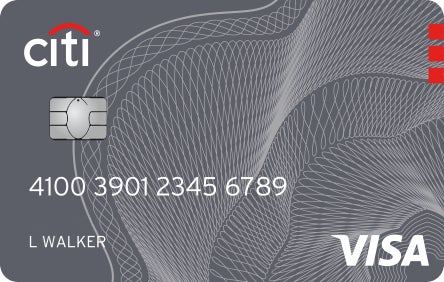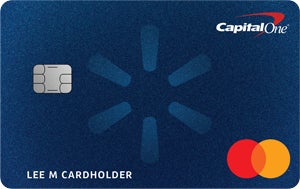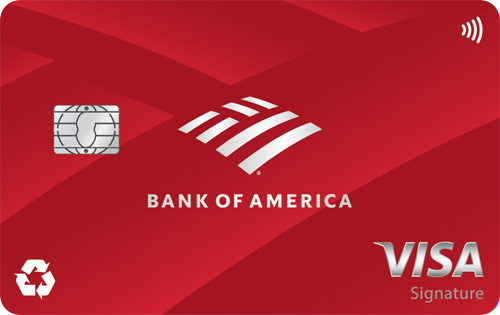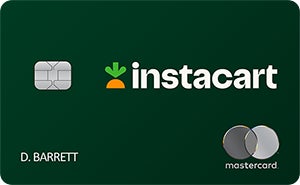| Rewards Rating: | 4.1 / 5 |
| Rewards Value | 4.0 |
| APR | 2.0 |
| Rewards Flexibility | 3.0 |
| Features | 3.0 |
| Issuer Customer Experience | 4.0 |
In a Nutshell:
If you’re already an avid Instacart user, this card could be hugely rewarding thanks to its impressive rewards rate, broad category coverage and generous first-year bonus. If you only use the service occasionally, though, you may be better off with a general grocery rewards card.
The information about the Instacart Mastercard® has been collected independently by Creditcards.com. The issuer did not provide the content, nor is it responsible for its accuracy.
Rewards Rate
|  |
Introductory Bonus Best Offer: Get a free year of Instacart+ and a $100 Instacart credit automatically upon approval. Membership auto-renews. Terms apply. |  |
Annual Bonus None |  |
Annual Fee |  |
APR |  |
Chase Customer Service Ratings
|  |
Other notable features: World Elite Concierge, baggage delay insurance, extended warranty protection, purchase protection, lost luggage reimbursement, travel and emergency assistance services, travel accident insurance, roadside assistance, auto rental collision damage waiver
If you’re already a frequent Instacart user and are looking for a way to earn rewards on your spending, the Instacart Mastercard could be a great fit. This co-branded rewards card comes with an impressive rewards rate on Instacart purchases, a solid sign-up bonus and decent redemption flexibility, which can be rare for these types of cards. Plus, the card also earns rewards across several of the most popular everyday rewards categories, including dining, gas and travel, making it viable as a standalone rewards option for Instacart fans.
If you only use Instacart occasionally, though, a general rewards card will likely be a better long-term value. Since most issuers reward Instacart purchases the same as any grocery store purchase, the best credit cards for groceries will give you the flexibility to buy groceries on your own or through Instacart without sacrificing rewards. The Instacart Mastercard’s rewards rate outside of Instacart purchases is also shrug-worthy since it’s matched by a standard 2% flat-rate cash back card.
Pros
- Offers one of the highest rewards rates available on groceries (assuming you pay through Instacart)
- Covers a wide array of everyday spending categories, making it viable as a standalone rewards card
- No spending requirement to earn the welcome offer, giving the card terrific first-year value
- You have multiple redemption options, including cash back, travel and, soon, the ability to pay with points
- Impressive set of cardholder perks for a co-branded, no-annual-fee card
Cons
- Other grocery rewards cards offer comparable rates on grocery purchases whether you use Instacart or not
- Instacart fees and price markups could overtake any rewards you earn with the card, so it only makes sense if you already use Instacart for most of your grocery shopping
- Doesn’t come with an introductory APR offer, so it won’t be useful if you need to finance large purchases or pay off debt
Why you might want the Instacart Mastercard
The Instacard Mastercard gives you a free Instacart+ membership for your first year, which comes with free delivery on orders over $35, reduced fees and more. On top of that, you’ll also earn 5% cash back on every Instacart app or Instacart.com purchases. The card also offers an impressive rewards rate in several other popular everyday spending categories, including restaurants, gas stations and streaming services, making it a potentially lucrative standalone option.
Earns rewards on a variety of everyday purchases
Foodies and frequent travelers should have little trouble earning points with the Instacart Mastercard. You’ll earn 5% cash back on all Instacart app and Instacart.com purchases, plus 5% cash back on travel bookings made through the Chase Travel℠ Portal. You’ll also earn 2% back at restaurants – including takeout and eligible delivery services – as well as at gas stations and on select streaming services. All other purchases earn 1% back.
That’s quite a broad range of eligible bonus categories. It covers nearly all of the average person’s most popular everyday purchases. And to top it off, rewards rates are unlimited and available year-round. Most competing cards only offer bonus rewards in a couple of major categories like groceries, travel, dining and gas at a time, but the Instacart Mastercard covers all of them (assuming you use Instacart for all your grocery shopping).
This gives you plenty of opportunity to earn cash back every day, especially on food, which can make up a significant part of a household budget. Even if you only use the card on Instacart purchases and spend $400 per month, you can earn up to $240 per year in cash back. Since there’s no minimum on redemption, you can enjoy cash back rewards at any time.
Solid sign-up bonus
The Instacart credit card comes with a $100 Instacart credit along with a free year of Instacart+ membership, a $99 annual value. If you’re already an Instacart+ member, this offer will let you extend your membership by a year at no cost.
Instacart+ gives households a 5% credit back on eligible pickup orders, free delivery on Instacart purchases over $35, reduced service fees and more. And if you combine the membership’s 5% credit on eligible pickup orders with the card’s 5% cash back on Instacart purchases, that could add up to an incredible 10% back on Instacart pickup orders for your first year as a cardholder.
That’s a total sign-up bonus value of $199 with no spending requirement – almost unheard-of even among no-annual-fee rewards cards. Competing everyday rewards cards typically require at least $500 in spending in your first three months to earn a $200 sign-up bonus. Keep in mind, however, that your bonus can only be applied to future Instacart purchases.
Redemption flexibility
The Instacart Mastercard offers a decent mix of redemption options. You can redeem rewards as cash back in the form of a statement credit or direct deposit, to cover travel through the Chase Ultimate Rewards and, in the future, toward all or part of your purchases in the Instacart app or Instacart.com.
Many cash back cards don’t give you the ability to redeem directly for travel, and most dedicated travel cards require you to sacrifice point value if you want to redeem rewards for cash back instead of travel bookings. This makes the Instacart Mastercard a good option for cardholders who’d rather not commit to one form of redemption and value having the flexibility to redeem for cash back or travel without worrying about diluting the value of their rewards.
Low card fees
Another plus of the Instacard Mastercard is its low cost. The card carries no annual fee and no foreign transaction fees. As long as you pay your balance on time and avoid late fees or the potentially high penalty APR, there’s little risk to keeping it in your wallet.
Just keep in mind that you’ll be automatically enrolled in an annual Instacart+ membership and will be charged $99 per year should you continue your membership beyond the first year. That said, you can cancel at any time, and Instacart+ membership isn’t required to keep the card, so you’re under no obligation should you no longer want to use the service.
Mastercard benefits
The Instacart Mastercard comes with a bevy of protections that help keep your purchases and travel plans safe. You get extended warranty protection on products with warranties of three years or less as well as purchase protection worth up to $500 per claim or $50,000 per year.
The card should also give you a bit more peace of mind when traveling thanks to the several types of travel insurance it includes, such as insurance that covers lost and delayed baggage, travel accidents and travel and emergency assistance services. Should you ever need help, there’s also the World Elite Concierge. The complimentary, 24/7 service helps you with travel bookings, finding concert tickets, getting restaurant reservations and more. They may also assist you in finding discounts for special events and items.
Why you might want a different card
The Instacart Mastercard is great for people who already use Instacart and want a co-branded rewards card they can integrate into their daily spending. However, it might not be the best fit even if earning rewards on groceries is your priority.
Subpar value for infrequent Instacart users
While the Instacart Mastercard should offer solid value for shoppers who already use Instacart for most of their grocery shopping and are accustomed to the fees and price markups that come with this convenience, people who only use the service occasionally may get more value out of a general rewards card, even if it offers a slightly lower rewards rate on groceries.
Several competing cards offer comparable rewards rates while charging a low or no annual fee. For example, either of the Blue Cash cards from American Express – the Blue Cash Everyday® Card from American Express and the Blue Cash Preferred® Card from American Express – could prove more valuable overall since you can earn rewards at U.S. supermarkets even if you don’t use Instacart. They also earn a higher cash back rate in some everyday categories like U.S. gas stations. Plus, like most grocery rewards cards, these cards count Instacart purchases as U.S. supermarket purchases as well, so you’ll still earn generous cash back on purchases made through the service.
Lack of extra features
Beyond its Mastercard benefits, the Instacart card lacks many ongoing perks. While that’s typically the case with most no-annual-fee cards, a handful of competing cards offer a bit more ongoing value via monthly or annual credits or exclusive discounts.
For example, the Blue Cash Everyday® Card from American Express offers a solid rewards rate on U.S. supermarket, gas station and online retail purchases as well as monthly streaming service credits worth up to $84 per year in cash back. Upon enrollment, you’ll earn $7 back each month after you use your card to spend $9.99 or more each month on an eligible subscription to The Disney Bundle, which includes Disney+, Hulu, and ESPN+ (subject to auto renewal). While that may not sound like a ton of money, keep in mind that it would typically take at least $1,680 in spending with the Instacart Mastercard to earn $84 in cash back (assuming you were earning 5% back on all those purchases).
No Intro APR offers
Unlike some no-annual-fee cash back and rewards cards, the Instacart Mastercard doesn’t offer an introductory APR on purchases or balance transfers that would allow you to pay off a balance over time while avoiding interest. Instead, should you have a balance on your card at the end of a billing cycle, you’ll have to pay the ongoing variable APR of 20.24% to 28.99%. This rate is pretty high, so interest charges can add up quickly on the card, making it less than ideal if you sometimes need to carry a balance or are looking for a way to pay down existing debt more efficiently.
How does the Instacart Mastercard compare to other cards?
While impressive as a co-branded card, the Instacart Mastercard card isn’t made for everyone. Consider these alternatives, which carry promotional APRs, have more valuable sign-up bonuses or offer more flexible rewards.
 |  |  |
Rewards rate
| Rewards rate
| Rewards rate
|
Sign-up bonus
| Sign-up bonus | Sign-up bonus |
| Annual fee $0 with paid Costco membership ($60) | Annual fee $0 | Annual fee $0 |
Other things to know
| Other things to know
| Other things to know
|
Instacart Mastercard vs. Costco Anywhere Visa® Card by Citi
Compared to the Costco Anywhere Visa Card by Citi, the Instacart Mastercard is likely the better choice for groceries and travel. The Instacart card offers a higher rewards rate for both and greater flexibility for grocery purchases since that rate applies to a variety of stores found in the app or on Instacart.com. Meanwhile the Costco card only offers 2%, which only applies to Costco and Costco.com purchases.
You may also have an easier time getting approved for the Instacart card. It’s open to applicants with good credit, while you’ll need excellent credit for the Costco card. But if you do qualify for the Costco card, you will enjoy an impressive cash back rate on gas and EV charging, which the Instacart card can’t match.
Instacart Mastercard vs. *Capital One Walmart Rewards® Mastercard®
The Instacart Mastercard and Capital One Walmart Rewards Mastercard share several similarities, so which is right for you will largely depend on where you shop and how frequently you use Instacart. If you do most of your grocery shopping with Walmart and don’t mind ordering online – whether for pickup or delivery – the Walmart card could be a more lucrative and flexible option thanks to its comparable rate on online purchases and higher rate on in-store purchases.
Neither card charges an annual fee and both can be used to earn 5% back on online grocery purchases (Instacart purchases and Walmart.com purchases, respectively). But the Walmart card may offer a slight advantage over the Instacart card. It’s open to people with fair credit and earns 2% back on Walmart in-store purchases. The Instacart card requires good credit and will only earn 1% on any grocery or retail purchases made outside the Instacart app or Instacart.com.
Like the Instacart card, the Walmart card also offers a unique sign-up bonus that has no set spending requirement: Instead of a cash bonus, you’ll enjoy an elevated rewards rate on in-store purchases when you use the Walmart Pay app for your first year. If you spend more than $2,000 at Walmart stores with Walmart Pay in your first year, that could beat out the $100 Instacart gift card most cardholders will get as their Instacart Mastercard bonus.
Instacart Mastercard vs. Bank of America® Customized Cash Rewards credit card
The Bank of America Customized Cash Rewards credit card is a general rewards credit card that could offer a bit more flexibility than the Instacart Mastercard. Instead of rewarding purchases with a specific brand, this card earns 3% back in an eligible category of your choice, including gas, online shopping, dining, travel, drug stores or home improvements and furnishings (on up to $2,500 in spending, then 1%). This card also comes with 0% Intro APR for 15 billing cycles for purchases and for balance transfers made in the first 60 days (18.74% - 28.74% Variable APR on purchases and balance transfers thereafter). A 3% intro balance transfer fee applies for 60 days from account opening, then 4%.
While the Instacart Mastercard has no spending cap, its rewards rate may not be as lucrative if you only shop with Instacart occasionally. If you’re looking for a more flexible rewards credit card with no annual fee, the Bank of America Customized Rewards card is a good choice.
How to use the Instacart Mastercard
- Use Instacart for groceries, whenever possible
- When planning a trip, use the Chase Travel℠ Portal
- Connect your card to your streaming services if you don’t have another card that offers higher than 2% cash back on entertainment.
Is the Instacart Mastercard worth it?
If you’re already using Instacart for your grocery needs, this card could offer terrific value. It not only comes with a great rewards rate on Instacart purchases, but also rewards a wide range of everyday purchases, making it viable as a standalone rewards card. Its sign-up bonus is also valuable given there’s no spending requirement.
That said, if you want the flexibility to shop outside of the Instacart app and Instacart.com while still earning rewards on grocery purchases, a general grocery rewards card will likely be a better fit, especially considering most issuers count Instacart spending as part of their grocery rewards categories.
*All information about the Walmart Rewards® Mastercard® has been collected independently by CreditCards.com and has not been reviewed by the issuer.
All reviews are prepared by CreditCards.com staff. Opinions expressed therein are solely those of the reviewer and have not been reviewed or approved by any advertiser. The information, including card rates and fees, presented in the review is accurate as of the date of the review. Check the data at the top of this page and the bank’s website for the most current information.
Responses to comments in the discussion section below are not provided, reviewed, approved, endorsed or commissioned by our financial partners. It is not our partner’s responsibility to ensure all posts or questions are answered.
